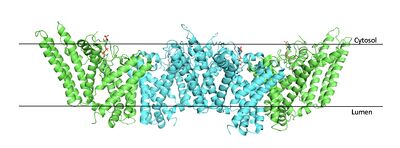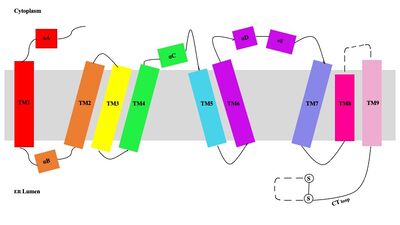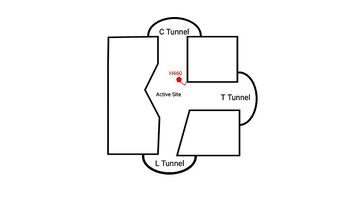User:Kaitlyn Roberts/Sandbox 2
From Proteopedia
(Difference between revisions)
| Line 26: | Line 26: | ||
== Inhibitors == | == Inhibitors == | ||
| - | [[Image:InhibitorCI976.jpeg|300 px|right|thumb|'''Figure 6. Structure of the CI-976 inhibitor''']] Depending on concentration and exposure, SOAT activity can be inhibited by CI-976 (Figure 6). When exposed, CI-976 locks itself in the <scene name='87/877559/Inhibitor_in_active_site_final/1'>catalytic center</scene> of the enzyme. The <scene name='87/877559/Residues_and_inhibitor/20'>trimethoxyphenyl head</scene> becomes sandwiched between the catalytic residues | + | [[Image:InhibitorCI976.jpeg|300 px|right|thumb|'''Figure 6. Structure of the CI-976 inhibitor''']] Depending on concentration and exposure, SOAT activity can be inhibited by CI-976 (Figure 6). When exposed, CI-976 locks itself in the <scene name='87/877559/Inhibitor_in_active_site_final/1'>catalytic center</scene> of the enzyme. The <scene name='87/877559/Residues_and_inhibitor/20'>trimethoxyphenyl head</scene> becomes sandwiched between the catalytic residues W420, N421, and H460. The interaction with these residues, as well as the location of the trimethoxyphenyl head, indicate that CI-976 acts as a [https://en.wikipedia.org/wiki/Competitive_inhibition competitive inhibitor] of SOAT by preventing substrates from accessing the catalytic center. Similar to interactions with the substrates, mutating the key catalytic residues (N421A, H460A, and H460N) results in a smaller effect of the inhibitor on the thermostability of the enzyme.<ref name="Guan" /> |
== Biological Relevance == | == Biological Relevance == | ||
| - | SOAT has gained interest when looking at its biological relevance because it has the ability to use a wide | + | SOAT has gained interest when looking at its biological relevance because it has the ability to use a wide range of sterols in it’s mechanistic activity. The wide variety of substrates has led to SOAT being focused on as a potential drug target for many different diseases. [https://en.wikipedia.org/wiki/Alzheimer%27s_disease Alzheimer’s disease], [https://en.wikipedia.org/wiki/Atherosclerosis atherosclerosis], and several types of cancers have show success in treatments when targeting the SOAT enzyme’s catalytic mechanism. <ref name="Guan" /> In summary, targeting SOAT could be an effective means for treating various diseases. Aberrant quantities of cholesteryl esters seem to hinder various cellular processes; thus, inhibiting SOAT expression and functionality could help reduce these adverse effects. Overall, SOAT plays an important role in cholesterol homeostasis and future research of this enzyme could lead to the discovery of therapeutic treatments for different illnesses. |
==== Alzheimer's Disease ==== | ==== Alzheimer's Disease ==== | ||
Revision as of 16:36, 27 April 2021
Human Sterol O-acyltransferase
| |||||||||||
References
- ↑ 1.0 1.1 1.2 1.3 1.4 1.5 1.6 Guan C, Niu Y, Chen SC, Kang Y, Wu JX, Nishi K, Chang CCY, Chang TY, Luo T, Chen L. Structural insights into the inhibition mechanism of human sterol O-acyltransferase 1 by a competitive inhibitor. Nat Commun. 2020 May 18;11(1):2478. doi: 10.1038/s41467-020-16288-4. PMID:32424158 doi:http://dx.doi.org/10.1038/s41467-020-16288-4
- ↑ 2.0 2.1 2.2 2.3 Qian H, Zhao X, Yan R, Yao X, Gao S, Sun X, Du X, Yang H, Wong CCL, Yan N. Structural basis for catalysis and substrate specificity of human ACAT1. Nature. 2020 May;581(7808):333-338. doi: 10.1038/s41586-020-2290-0. Epub 2020 May, 13. PMID:32433614 doi:http://dx.doi.org/10.1038/s41586-020-2290-0
- ↑ Das A, Davis MA, Rudel LL. Identification of putative active site residues of ACAT enzymes. J Lipid Res. 2008 Aug;49(8):1770-81. doi: 10.1194/jlr.M800131-JLR200. Epub 2008, May 13. PMID:18480028 doi:http://dx.doi.org/10.1194/jlr.M800131-JLR200
- ↑ Guo ZY, Lin S, Heinen JA, Chang CC, Chang TY. The active site His-460 of human acyl-coenzyme A:cholesterol acyltransferase 1 resides in a hitherto undisclosed transmembrane domain. J Biol Chem. 2005 Nov 11;280(45):37814-26. doi: 10.1074/jbc.M508384200. Epub 2005, Sep 8. PMID:16154994 doi:http://dx.doi.org/10.1074/jbc.M508384200
- ↑ 5.0 5.1 Bhattacharyya R, Kovacs DM. ACAT inhibition and amyloid beta reduction. Biochim Biophys Acta. 2010 Aug;1801(8):960-5. doi: 10.1016/j.bbalip.2010.04.003. , Epub 2010 Apr 14. PMID:20398792 doi:http://dx.doi.org/10.1016/j.bbalip.2010.04.003
- ↑ 6.0 6.1 Huttunen HJ, Kovacs DM. ACAT as a drug target for Alzheimer's disease. Neurodegener Dis. 2008;5(3-4):212-4. doi: 10.1159/000113705. Epub 2008 Mar 6. PMID:18322393 doi:http://dx.doi.org/10.1159/000113705
- ↑ Chang C, Dong R, Miyazaki A, Sakashita N, Zhang Y, Liu J, Guo M, Li BL, Chang TY. Human acyl-CoA:cholesterol acyltransferase (ACAT) and its potential as a target for pharmaceutical intervention against atherosclerosis. Acta Biochim Biophys Sin (Shanghai). 2006 Mar;38(3):151-6. doi:, 10.1111/j.1745-7270.2006.00154.x. PMID:16518538 doi:http://dx.doi.org/10.1111/j.1745-7270.2006.00154.x
- ↑ Ayyagari VN, Wang X, Diaz-Sylvester PL, Groesch K, Brard L. Assessment of acyl-CoA cholesterol acyltransferase (ACAT-1) role in ovarian cancer progression-An in vitro study. PLoS One. 2020 Jan 24;15(1):e0228024. doi: 10.1371/journal.pone.0228024., eCollection 2020. PMID:31978092 doi:http://dx.doi.org/10.1371/journal.pone.0228024
Student Contributors
- Kylie Pfeifer
- Stephanie Pellegrino
- Kaitlyn Roberts






